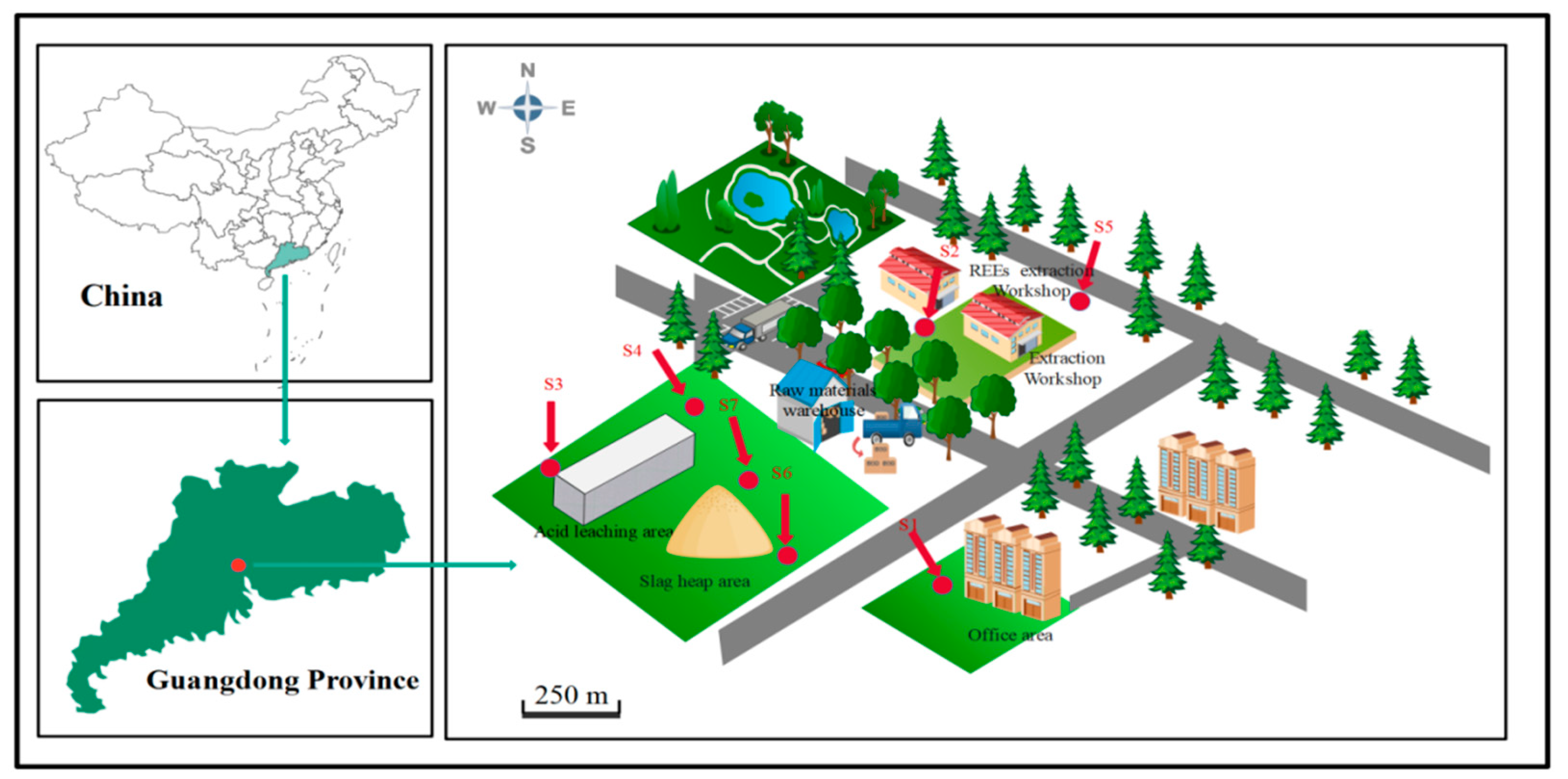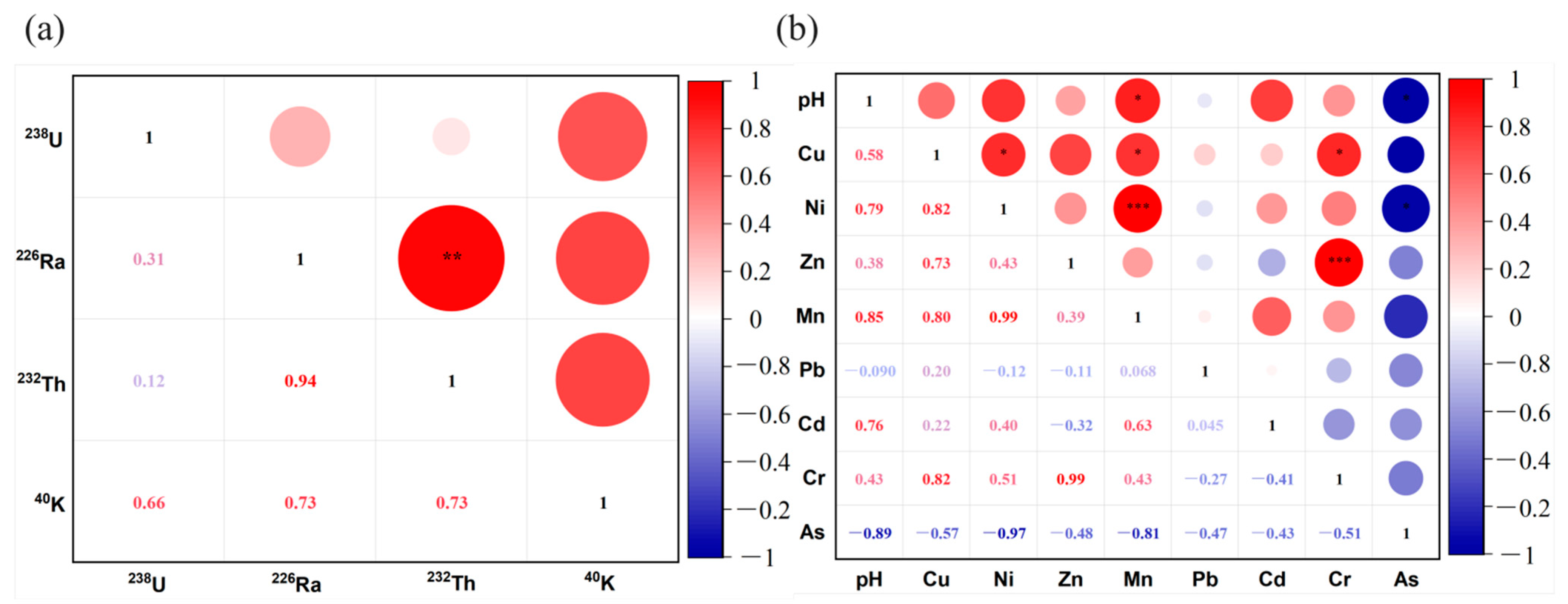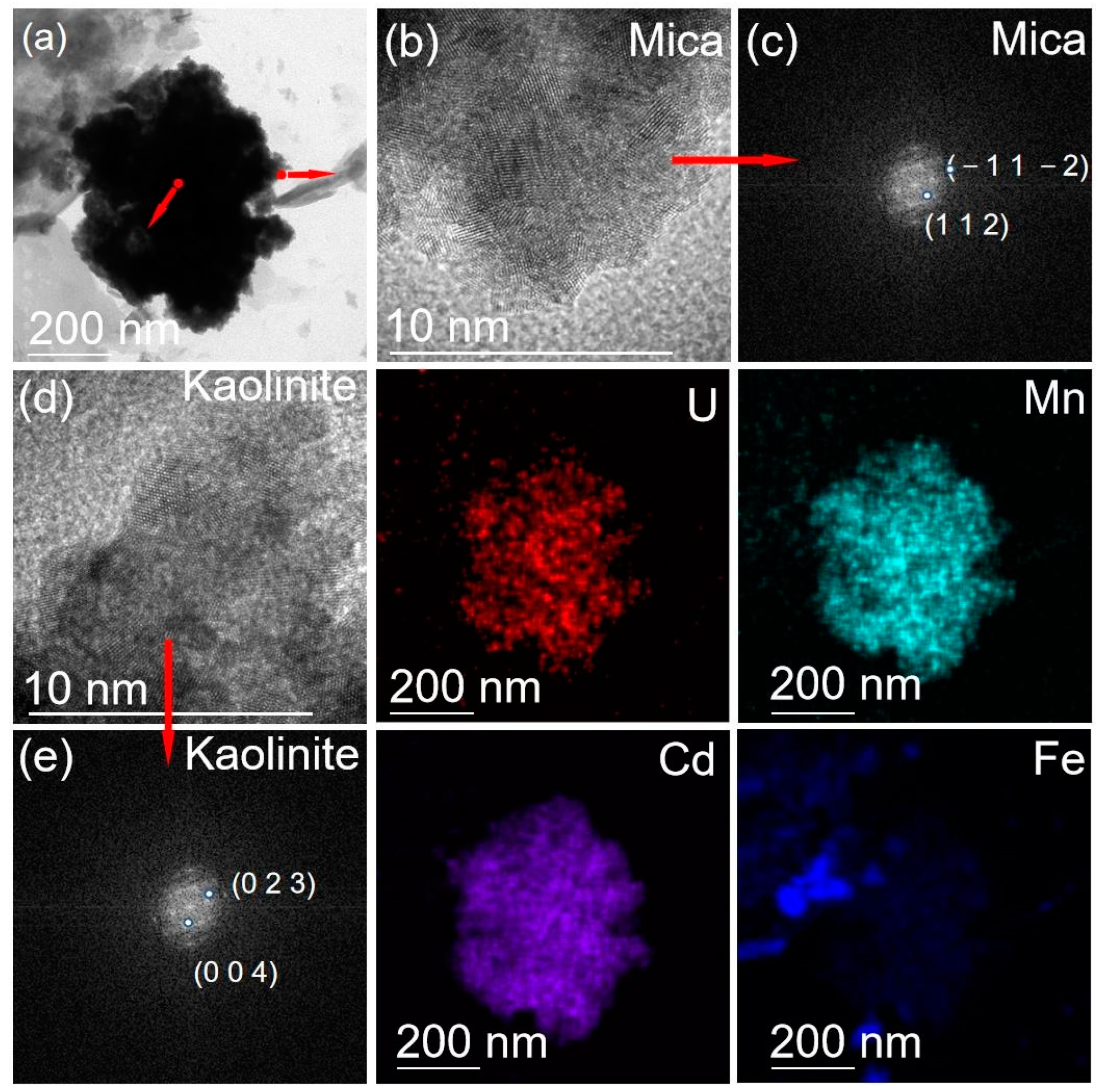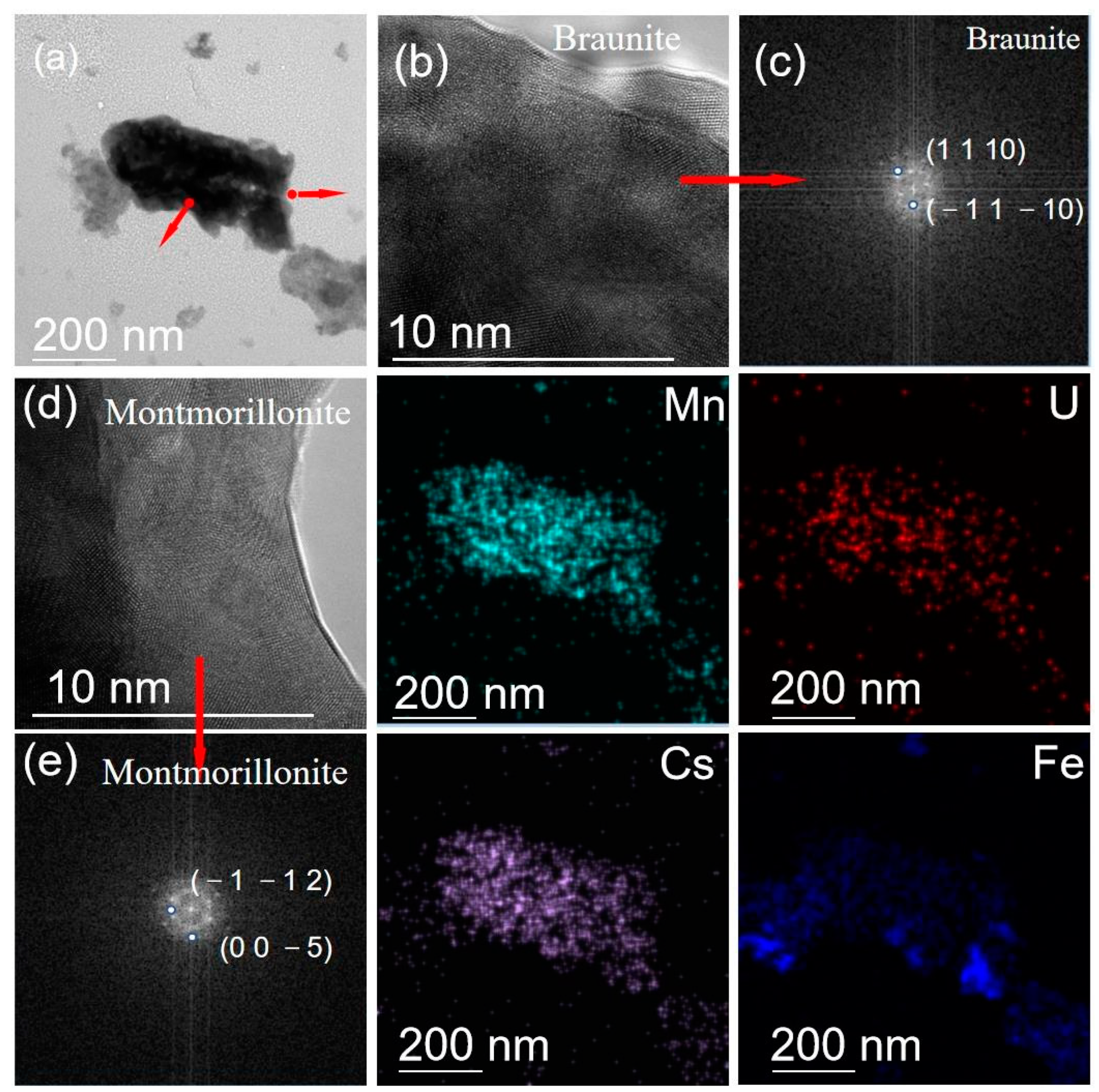Preliminary Screening of Soils Natural Radioactivity and Metal(loid) Content in a Decommissioned Rare Earth Elements Processing Plant, Guangdong, China
Abstract
1. Introduction
2. Materials and Methods
2.1. Site information and Sample Collection and Treatment
2.2. Measurement of Air-Absorbed Dose Rate of γ Radiation and Specific Radioactivity
2.3. Radiation Exposure Assessment
2.4. Determination of PMTs Content and Risk Assessment
2.5. Statistical Analysis
2.6. Soil Mineralogical Composition Characterizations
3. Results and Discussion
3.1. Radioactivity Level of Surveyed Soils
3.2. Air-Absorbed Dose Rate of γ Radiation
3.3. Pollution Evaluation on the Basis of PMTs Content
4. Conclusions, Study Limitation and Perspective
Author Contributions
Funding
Institutional Review Board Statement
Informed Consent Statement
Data Availability Statement
Acknowledgments
Conflicts of Interest
References
- Dang, D.H.; Thompson, K.A.; Ma, L.; Nguyen, H.Q.; Luu, S.T.; Duong, M.T.N.; Kernaghan, A. Toward the Circular Economy of Rare Earth Elements: A Review of Abundance, Extraction, Applications, and Environmental Impacts. Arch. Environ. Contam. Toxicol. 2021, 81, 521–530. [Google Scholar] [CrossRef] [PubMed]
- Wang, J.; Liu, J.; Chen, Y.; Song, G.; Chen, D.; Xiao, T.; Wu, S.; Chen, F.; Yin, M. Technologically Elevated Natural Radioactivity and Assessment of Dose to Workers around a Granitic Uranium Deposit Area, China. J. Radioanal. Nucl. Chem. 2016, 310, 733–741. [Google Scholar] [CrossRef]
- Milinovic, J.; Rodrigues, F.J.; Barriga, F.J.; Murton, B.J. Ocean-Floor Sediments as a Resource of Rare Earth Elements: An Overview of Recently Studied Sites. Minerals 2021, 11, 142. [Google Scholar] [CrossRef]
- Xu, C.; Kynicky, J.; Chakhmouradian, A.R.; Campbell, I.H.; Allen, C.M. Trace-Element Modeling of the Magmatic Evolution of Rare-Earth-Rich Carbonatite from the Miaoya Deposit, Central China. Lithos 2010, 118, 145–155. [Google Scholar] [CrossRef]
- Obrador, E.; Salvador-Palmer, R.; Villaescusa, J.I.; Gallego, E.; Pellicer, B.; Estrela, J.M.; Montoro, A. Nuclear and Radiological Emergencies: Biological Effects, Countermeasures and Biodosimetry. Antioxidants 2022, 11, 1098. [Google Scholar] [CrossRef]
- Liu, C.; Yuan, M.; Liu, W.-S.; Guo, M.-N.; Zheng, H.-X.; Huot, H.; Jally, B.; Tang, Y.-T.; Laubie, B.; Simonnot, M.-O. Element Case Studies: Rare Earth Elements. In Agromining: Farming for Metals; Springer: Berlin/Heidelberg, Germany, 2021; pp. 471–483. [Google Scholar]
- Ou, X.; Chen, Z.; Chen, X.; Li, X.; Wang, J.; Ren, T.; Chen, H.; Feng, L.; Wang, Y.; Chen, Z. Redistribution and Chemical Speciation of Rare Earth Elements in an Ion–Adsorption Rare Earth Tailing, Southern China. Sci. Total Environ. 2022, 821, 153369. [Google Scholar] [CrossRef]
- Wang, J.; Liu, S.; Wei, X.; Beiyuan, J.; Wang, L.; Liu, J.; Sun, H.; Zhang, G.; Xiao, T. Uptake, Organ Distribution and Health Risk Assessment of Potentially Toxic Elements in Crops in Abandoned Indigenous Smelting Region. Chemosphere 2022, 292, 133321. [Google Scholar] [CrossRef]
- Wang, J.; Wang, L.; Wang, Y.; Tsang, D.; Yang, X.; Beiyuan, J.; Yin, M.; Xiao, T.; Jiang, Y.; Lin, W.; et al. Emerging risks of toxic metal(loid)s in soil-vegetables influenced by steel-making activities and isotopic source apportionment. Environ. Int. 2021, 146, 106207. [Google Scholar] [CrossRef]
- Mancheri, N.A.; Sprecher, B.; Bailey, G.; Ge, J.; Tukker, A. Effect of Chinese Policies on Rare Earth Supply Chain Resilience. Resour. Conserv. Recycl. 2019, 142, 101–112. [Google Scholar] [CrossRef]
- Wang, L.; Liang, T. Geochemical Fractions of Rare Earth Elements in Soil around a Mine Tailing in Baotou, China. Sci. Rep. 2015, 5, 12483. [Google Scholar] [CrossRef]
- Xie, L.; Wu, W.; Huang, X.; Ou, P.; Lin, Z.; Wang, Z.; Song, Y.; Lang, T.; Huangfu, W.; Zhang, Y. Mining and Restoration Monitoring of Rare Earth Element (REE) Exploitation by New Remote Sensing Indicators in Southern Jiangxi, China. Remote Sens. 2020, 12, 3558. [Google Scholar] [CrossRef]
- Xu, X.; Qin, L.; Meng, L. Protection Measure and Sustainable Development on Eco-Geological Environment of Rare Earth Mining in Southern Jiangxi Province. In Proceedings of the 2012 2nd International Conference on Remote Sensing, Environment and Transportation Engineering, Nanjing, China, 1–3 June 2012; pp. 1–4. [Google Scholar]
- Humsa, T.Z.; Srivastava, R.K. Impact of Rare Earth Mining and Processing on Soil and Water Environment at Chavara, Kollam, Kerala: A Case Study. Procedia Earth Planet. Sci. 2015, 11, 566–581. [Google Scholar] [CrossRef]
- Phua, K.L. Rare Earth Plant in Malaysia: Governance, Green Politics, and Geopolitics. Southeast Asian Stud. 2016, 5, 443–462. [Google Scholar]
- Shin, S.-H.; Kim, H.-O.; Rim, K.-T. Worker Safety in the Rare Earth Elements Recycling Process from the Review of Toxicity and Issues. Saf. Health Work 2019, 10, 409–419. [Google Scholar] [CrossRef] [PubMed]
- Sanjuán, M.Á.; Suarez-Navarro, J.A.; Argiz, C.; Mora, P. Assessment of Radiation Hazards of White and Grey Portland Cements. J. Radioanal. Nucl. Chem. 2019, 322, 1169–1177. [Google Scholar] [CrossRef]
- Shahrokhi, A.; Adelikhah, M.; Chalupnik, S.; Kocsis, E.; Toth-Bodrogi, E.; Kovács, T. Radioactivity of Building Materials in Mahallat, Iran—An Area Exposed to a High Level of Natural Background Radiation—Attenuation of External Radiation Doses. Mater. Constr. 2020, 70, 233. [Google Scholar] [CrossRef]
- Ajaj, R.; Shubyar, N.; Alashban, Y.; El-Sayed, S.; Salah, T.; Al Yafei, M.A.S. Determination of Primordial Radionuclide Concentrations in UAE Groundwater Using High-Resolution Gamma-Ray Spectrometry. J. Radioanal. Nucl. Chem. 2021, 330, 923–928. [Google Scholar] [CrossRef]
- Chen, H.; Gong, C. Characteristic and Evaluation of Soil Pollution by Heavy Metal in Different Functional Zones of Guangzhou. J. Environ. Health 2010, 27, 700–703. [Google Scholar]
- Cheng, H.; Li, K.; Li, M.; Yang, K.; Liu, F.; Cheng, X. Geochemical Background and Baseline Value of Chemical Elements in Urban Soil in China. Earth Sci. Front. 2014, 21, 265–306. [Google Scholar]
- Liu, J.; Ouyang, Q.; Wang, L.; Wang, J.; Zhang, Q.; Wei, X.; Lin, Y.; Zhou, Y.; Yuan, W.; Xiao, T. Quantification of Smelter-Derived Contributions to Thallium Contamination in River Sediments: Novel Insights from Thallium Isotope Evidence. J. Hazard. Mater. 2022, 424, 127594. [Google Scholar] [CrossRef]
- Wei, X.; Zhou, Y.; Tsang, D.C.W.; Song, L.; Zhang, C.; Yin, M.; Liu, J.; Xiao, T.; Zhang, G.; Wang, J. Hyperaccumulation and Transport Mechanism of Thallium and Arsenic in Brake Ferns (Pteris vittata L.): A Case Study from Mining Area. J. Hazard. Mater. 2020, 388, 121756. [Google Scholar] [CrossRef] [PubMed]
- Singh, S.; Rani, A.; Kumar Mahajan, R. 226Ra, 232Th and 40K Analysis in Soil Samples from Some Areas of Punjab and Himachal Pradesh, India Using Gamma Ray Spectrometry. Radiat. Meas. 2005, 39, 431–439. [Google Scholar] [CrossRef]
- Ahmed, R.S.; Mohammed, R.S.; Abdaljalil, R.O. The Activity Concentrations and Radium Equivalent Activity in Soil Samples Collected from the Eastern Part of Basrah Governorate in Southern Iraq. Int. J. Anal. Chem. 2018, 2018, 1–11. [Google Scholar] [CrossRef] [PubMed]
- Monged, M.H.; Hassan, H.B.; El-Sayed, S.A. Spatial Distribution and Ecological Risk Assessment of Natural Radionuclides and Trace Elements in Agricultural Soil of Northeastern Nile Valley, Egypt. Water Air Soil Pollut. 2020, 231, 338. [Google Scholar] [CrossRef]
- Zivuku, M. Radionuclides and Heavy Metals Concentrations in Particulate Matter around Uranium and Gold Mining Towns of Erongo Region, Namibia; North-West University: Mahikeng, South Africa, 2020. [Google Scholar]
- Wang, L.; Lu, X. Natural Radionuclide Concentrations in Soils around Baoji Coal-Fired Power Plant, China. Radiat. Eff. Defects Solids 2007, 162, 677–683. [Google Scholar] [CrossRef]
- Ugbede, F.O.; Akpolile, A.F.; Ibeh, G.F.; Mokobia, C.E. In-Situ Assessment of Background Gamma Radiation Dose Levels in Outdoor Environment of Enugu Urban Areas, Enugu State, Nigeria. Environ. Forensics 2022, 23, 334–345. [Google Scholar] [CrossRef]
- Adagunodo, T.A.; George, A.I.; Ojoawo, I.A.; Ojesanmi, K.; Ravisankar, R. Radioactivity and Radiological Hazards from a Kaolin Mining Field in Ifonyintedo, Nigeria. MethodsX 2018, 5, 362–374. [Google Scholar] [CrossRef]
- Kamunda, C.; Mathuthu, M.; Madhuku, M. An Assessment of Radiological Hazards from Gold Mine Tailings in the Province of Gauteng in South Africa. Int. J. Environ. Res. Public Health 2016, 13, 138. [Google Scholar] [CrossRef] [PubMed]
- Mei-Wo, Y.; Mahmood, Z.U.W.; Ishak, A.K.; Yusof, M.A.W.; Razalim, F.A.A. Natural Radioactivity in Surface Soil and Its Radiation Risk Implications in the Vicinity of Lynas Rare-Earth Plant at Gebeng, Kuantan; Konvensyen Teknikal Nuklear Malaysia: Malaysia, 2015; pp. 3–5. [Google Scholar]
- Li, B.; Wang, N.; Wan, J.; Xiong, S.; Liu, H.; Li, S.; Zhao, R. In-Situ Gamma-Ray Survey of Rare-Earth Tailings Dams–A Case Study in Baotou and Bayan Obo Districts, China. J. Environ. Radioact. 2016, 151, 304–310. [Google Scholar] [CrossRef]
- Orosun, M.M.; Ajibola, T.B.; Akinyose, F.C.; Osanyinlusi, O.; Afolayan, O.D.; Mahmud, M.O. Assessment of Ambient Gamma Radiation Dose and Annual Effective Dose Associated with Radon in Drinking Water from Gold and Lead Mining Area of Moro, North-Central Nigeria. J. Radioanal. Nucl. Chem. 2021, 328, 129–136. [Google Scholar] [CrossRef]
- Loan, T.T.H.; Ba, V.N.; Thien, B.N. Natural Radioactivity Level in Fly Ash Samples and Radiological Hazard at the Landfill Area of the Coal-Fired Power Plant Complex, Vietnam. Nucl. Eng. Technol. 2022, 54, 1431–1438. [Google Scholar] [CrossRef]
- United Nations Scientific Committee on the Effects of Atomic Radiation. Report of the United Nations Scientific Committee on the Effects of Atomic Radiation 2014: Sixty-First Session; United Nations: New York, NY, USA, 2014; pp. 10–25. ISBN 92-1-057388-9. [Google Scholar]
- Cui, F.; Yuan, B. The Remediation Standards and Evaluation Methods for Remediation Effectiveness of Contaminated Soil. Adv. Mater. Res. 2011, 414, 68–75. [Google Scholar] [CrossRef]
- Liu, J.; Wang, J.; Chen, Y.; Xie, X.; Qi, J.; Lippold, H.; Luo, D.; Wang, C.; Su, L.; He, L.; et al. Thallium Transformation and Partitioning during Pb–Zn Smelting and Environmental Implications. Environ. Pollut. 2016, 212, 77–89. [Google Scholar] [CrossRef] [PubMed]
- Wang, N.; Yin, Q.; Du, X. Experimental Investigation into the Performances of Water Adsorption in Kaolinite Clay: Implications for Occupational Pneumoconiosis Prevention and Treatment. J. Taibah Univ. Sci. 2022, 16, 535–549. [Google Scholar] [CrossRef]
- Yang, R.; Wang, W.; Zhang, X.; Liu, L.; Wei, H.; Bao, M.; Wang, J. A New Type of Rare Earth Elements Deposit in Weathering Crust of Permian Basalt in Western Guizhou, NW China. J. Rare Earths 2008, 26, 753–759. [Google Scholar] [CrossRef]





| Method Code | ME-MS61r | ME-MS61r | ME-MS61r | ME-MS61r | ME-MS61r | ME-MS61r | ME-MS61r | ME-MS61r |
|---|---|---|---|---|---|---|---|---|
| Elements | Cu | Ni | Zn | Mn | Pb | Cd | Cr | As |
| Units | μg/g | μg/g | μg/g | μg/g | μg/g | μg/g | μg/g | μg/g |
| LOD | 0.2 | 0.2 | 2 | 5 | 0.5 | 0.02 | 1 | 0.2 |
| OREAS-45h | 766 | 425 | 37 | 379 | 12.1 | <0.02 | 612 | 18.4 |
| OREAS-45h | 803 | 449 | 40 | 391 | 11.7 | <0.02 | 644 | 18.5 |
| OREAS-45h | 805 | 447 | 40 | 397 | 11.6 | <0.02 | 647 | 17.8 |
| Reference value | 767 | 423 | 40 | 380 | 11.9 | 0.01 | 602 | 16.9 |
| Blank | <0.2 | <0.2 | <2 | <5 | <0.5 | <0.02 | <1 | <0.2 |
| Sample | 238U | 226Ra | 232Th | 40K |
|---|---|---|---|---|
| S1 | 328.2 | 236.6 | 277.7 | 968.5 |
| S2 | 1990.2 | 3767.2 | 2936.9 | 2157.6 |
| S3 | 80.8 | 68.2 | 78.4 | 1020.8 |
| S4 | 121.6 | 6196.2 | 8582.6 | 1045.3 |
| S5 | 654.4 | 6935.0 | 14,372.4 | 2698.4 |
| S6 | 182.1 | 99.6 | 151.1 | 625.4 |
| S7 | 275.1 | 670.8 | 343.7 | 856.2 |
| Range | 80.8–1990.2 | 68.2–6935.0 | 78.4–8582.6 | 625.4–2698.4 |
| Arithmetic mean | 518.9 | 2567.7 | 3820.4 | 1338.9 |
| Worldwide average * | 40 | 35 | 30 | 400 |
| Sampling Point | Site Properties | Measured Values | ||
|---|---|---|---|---|
| Range | Average | Reference | ||
| S1 | REE plant | 149–163 | 155 | present study |
| S2 | 780–860 | 826 | present study | |
| S3 | 221–251 | 231 | present study | |
| S4 | 371–4004 | 1610 | present study | |
| S5 | 2020–2231 | 2122 | present study | |
| S6 | 280–331 | 305 | present study | |
| S7 | 301–383 | 347 | present study | |
| Enugu state, Nigeria | Outdoor environment of urban areas | 77.21–180.53 | 124.92 | [29] |
| Ifonyintedo, Nigeria | Kaolin mining field | NG | 59.6 | [30] |
| Gauteng, South Africa | Gold mine tailings | NG | 407.1 | [31] |
| Gebeng, Kuantan | REE plant | 29–118 | 65 | [32] |
| Baotou and Bayan Obo, China | REE tailings dams | 120–283 | 150 | [33] |
| Moro, North-Central Nigeria | Gold and lead mining area | 56.30–90.30 | 77.11 | [34] |
| Binh Thuan, Vietnam | Coal-fired power plant | 91.47–155.81 | 130.24 | [35] |
| Worldwide average | Outdoor environment | NG | 59 | [36] |
| Sampling Site | Ractivity/Bq·kg−1 | Dacdr/μSv·a−1 | Ir |
|---|---|---|---|
| S1 | 708.3 | 190.1 | 1.91 |
| S2 | 8133.1 | 1013.0 | 21.97 |
| S3 | 258.9 | 283.3 | 0.70 |
| S4 | 18549.8 | 1974.5 | 50.10 |
| S5 | 27,695.3 | 2602.4 | 74.80 |
| S6 | 363.8 | 374.1 | 0.98 |
| S7 | 1228.2 | 425.6 | 3.32 |
| Mineral | Chemical Formula | S1 | S2 | S5 | S6 | S7 |
|---|---|---|---|---|---|---|
| Quartz | SiO2 | **** | **** | ***** | ** | ** |
| Kaolinite | Al4(OH)8(Si4O10) | ***** | ***** | |||
| Norsethite | BaMg(CO3)2 | * | ||||
| Calcite | CaCO3 | **** | ||||
| Nepheline | KNa3(AlSiO4)2 | **** | ||||
| Cuprite | Cu2O | **** | ||||
| Halite | NaCl | **** | ||||
| Arsenic phosphorus oxide | AsPO5 | **** | ||||
| Quenselite | PbMnO2OH | ** | ||||
| Copper silicon selenide | Cu8SiSe6 | **** | ||||
| Cerussite | PbCO3 | ** | ||||
| Lead arsenate | Pb(As2O6) | **** |
Publisher’s Note: MDPI stays neutral with regard to jurisdictional claims in published maps and institutional affiliations. |
© 2022 by the authors. Licensee MDPI, Basel, Switzerland. This article is an open access article distributed under the terms and conditions of the Creative Commons Attribution (CC BY) license (https://creativecommons.org/licenses/by/4.0/).
Share and Cite
Huang, Y.; Wen, W.; Liu, J.; Liang, X.; Yuan, W.; Ouyang, Q.; Liu, S.; Gok, C.; Wang, J.; Song, G. Preliminary Screening of Soils Natural Radioactivity and Metal(loid) Content in a Decommissioned Rare Earth Elements Processing Plant, Guangdong, China. Int. J. Environ. Res. Public Health 2022, 19, 14566. https://doi.org/10.3390/ijerph192114566
Huang Y, Wen W, Liu J, Liang X, Yuan W, Ouyang Q, Liu S, Gok C, Wang J, Song G. Preliminary Screening of Soils Natural Radioactivity and Metal(loid) Content in a Decommissioned Rare Earth Elements Processing Plant, Guangdong, China. International Journal of Environmental Research and Public Health. 2022; 19(21):14566. https://doi.org/10.3390/ijerph192114566
Chicago/Turabian StyleHuang, Yaole, Wangfeng Wen, Juan Liu, Xiaoliang Liang, Wenhuan Yuan, Qi’en Ouyang, Siyu Liu, Cem Gok, Jin Wang, and Gang Song. 2022. "Preliminary Screening of Soils Natural Radioactivity and Metal(loid) Content in a Decommissioned Rare Earth Elements Processing Plant, Guangdong, China" International Journal of Environmental Research and Public Health 19, no. 21: 14566. https://doi.org/10.3390/ijerph192114566
APA StyleHuang, Y., Wen, W., Liu, J., Liang, X., Yuan, W., Ouyang, Q., Liu, S., Gok, C., Wang, J., & Song, G. (2022). Preliminary Screening of Soils Natural Radioactivity and Metal(loid) Content in a Decommissioned Rare Earth Elements Processing Plant, Guangdong, China. International Journal of Environmental Research and Public Health, 19(21), 14566. https://doi.org/10.3390/ijerph192114566









